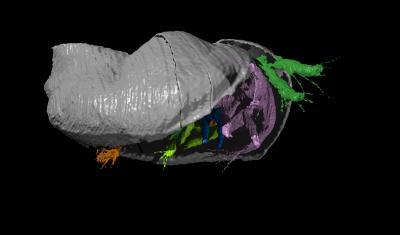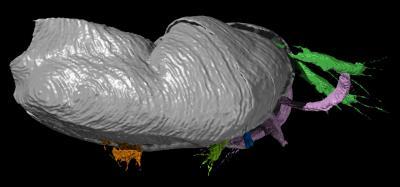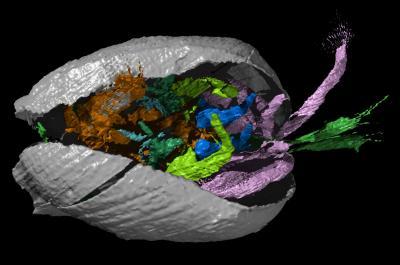Researchers have announced discovery of a species of animal related to crabs, lobsters and shrimps that is new to science.
A tiny shelled arthropod was found in 425 million-year-old rocks in Herefordshire, Welsh Borderland. The rocks at the site date to the Silurian period of geological time, when southern Britain was a sea area on a small continent situated in warm, southerly subtropical latitudes. The ostracods and associated marine animals living there were covered by a fall of volcanic ash that preserved them frozen in time.
The new, 10 millimeter long fossil is special because it is exceptionally well preserved: complete with not only the shell but also the soft parts – its body, limbs, eyes, gills and alimentary system. Such discoveries are extremely rare in the fossil record.

Oblique frontal view of Pauline avibella. Credit: David J. Siveter, Derek E. G. Briggs, Derek J. Siveter, Mark D. Sutton and Sarah C. Joomun
"The two ostracod specimens discovered represent a genus and species new to science, named Pauline avibella," said Professor David Siveter, of the University of Leicester Department of Geology. "Ostracods are the most abundant fossil arthropods, occurring ubiquitously as bivalved shells in rocks of the last 490 million years, and are common in most water environments today. The find is important because it is one of only a handful preserving the fossilised soft-tissues of ostracods. Its assignment to a particular group of ostracods based on knowledge of its biology is at odds with its shell form, thus urging caution in interpreting the classification of fossil ostracods based on shell characters alone.
"The preservation of soft-parts of animals is a very rare occurrence in the fossil record and allows unparalleled insight into the ancient biology, community structure and evolution of animals - key facts that that would otherwise be lost to science. The fossils known from the Herefordshire site show soft-part preservation and are of global importance."

Right lateral view of the fossil Pauline avibella. Credit: David J. Siveter, Derek E. G. Briggs, Derek J. Siveter, Mark D. Sutton and Sarah C. Joomun.
The fossils were reconstructed 'virtually', by using a technique that involves grinding each specimen down, layer by layer, and photographing it at each stage. Ten millimeters is relatively tiny, but at an incremental level of 20 µm (micrometers) that yields 500 slices, which can then be pieced together in a computer to provide a full, three-dimensional image of each fossil, outside and in.
Siveter added, "Fossil discoveries in general help elucidate our own place in the tree of life. This discovery adds another piece of knowledge in the jigsaw of understanding the diversity and evolution of animals. It is exciting to discover that a common group of fossils that we thought we knew a lot about may well have been hood-winking us as to their true identity, which we now realise because we have their beautifully fossilised soft-parts. A case of a 'wolf in sheep's clothing'."

This shows the ventral view of the fossil Pauline avibella. Credit: David J. Siveter, Derek E. G. Briggs, Derek J. Siveter, Mark D. Sutton and Sarah C. Joomun
The species of ostracod was announced in the journal, Proceedings of The Royal Society B.





Comments